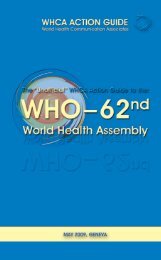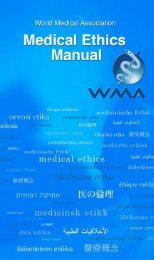the basics - World Health Communication Associates
the basics - World Health Communication Associates
the basics - World Health Communication Associates
- No tags were found...
You also want an ePaper? Increase the reach of your titles
YUMPU automatically turns print PDFs into web optimized ePapers that Google loves.
TABLE 3. EFFECTIVE VERBAL COMMUNICATION TECHNIQUES<strong>Communication</strong>TechniqueExplanationTalk slowlyEncourage questionsExplain things in clear,plain languageAvoid complexnumerical conceptsand statisticsUse analogies andmetaphorsLimit informationprovidedVerify patientunderstandingAvoid vague termsSlow down <strong>the</strong> pace of speech when talking with a patient.An effective way to solicit questions would be to ask “Whatquestions do you have?” This is an open-ended questionand allows <strong>the</strong> patient more room for possible interactivecommunication with <strong>the</strong>ir provider. Questions such as “Do youunderstand?”, “Do you have questions?”, and “Do you think youcan (check your blood sugars now)?” are vague and give <strong>the</strong>patient <strong>the</strong> opportunity to avoid <strong>the</strong> question with a simple “no”answer.Plain, non-medical language should be used. New terms shouldbe defined. Words or expressions that are familiar to patientsshould be used, such as “pain-killer” instead of “analgesic”.Jargon, statistics, and technical phrases should be avoided.Many people do not understand percentages. Patients do notunderstand all <strong>the</strong> numbers given to <strong>the</strong>m before <strong>the</strong>y make anytreatment decision. Instead of saying, “There is a 20% chancethat you will experience X outcome,” you can tell <strong>the</strong> patient “20out of 100 people will experience X outcome.”Analogies should be selected to relate complex concepts tothings <strong>the</strong> patient already knows (e.g., “Arthritis is like a creakyhinge on a door.”).Limit information to 1-3 key messages per visit. Reviewing andrepeating each point helps reinforce <strong>the</strong> messages. In addition, itis important that o<strong>the</strong>r staff should reinforce <strong>the</strong> key messages.A “teach-back” or “show me” method should be used to allow<strong>the</strong> patient to demonstrate understanding and for <strong>the</strong> healthprofessional to verify patient understanding.Say “Take 1 hour before you eat breakfast” instead of “Take on anempty stomach.”SECTION 4: WHAT CAN WE DO TO STRENGTHEN HEALTH LITERACY? 41






